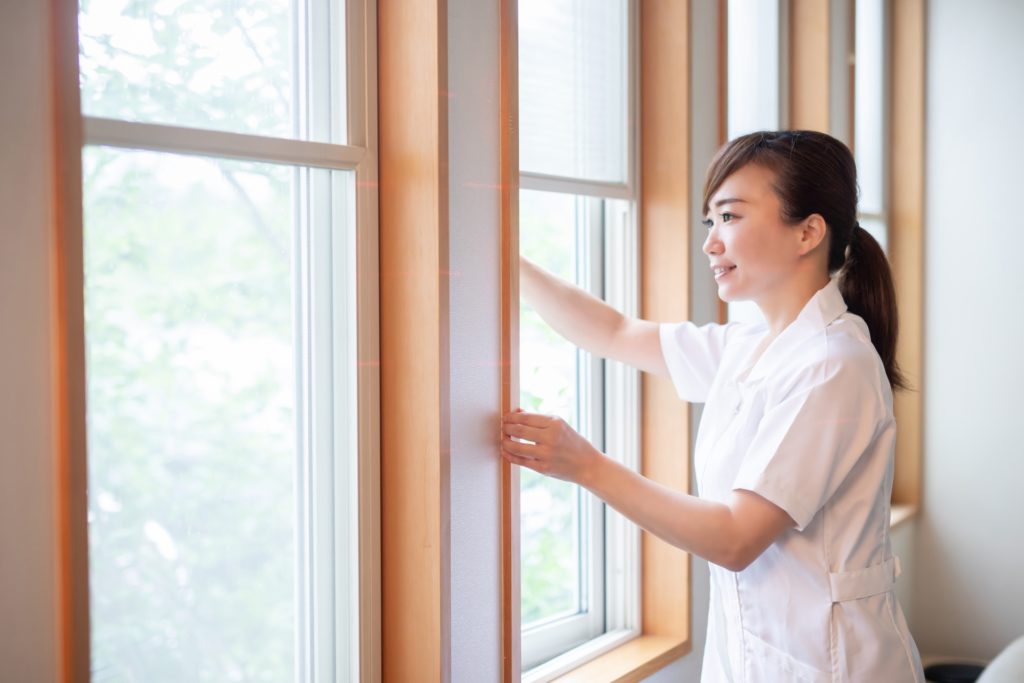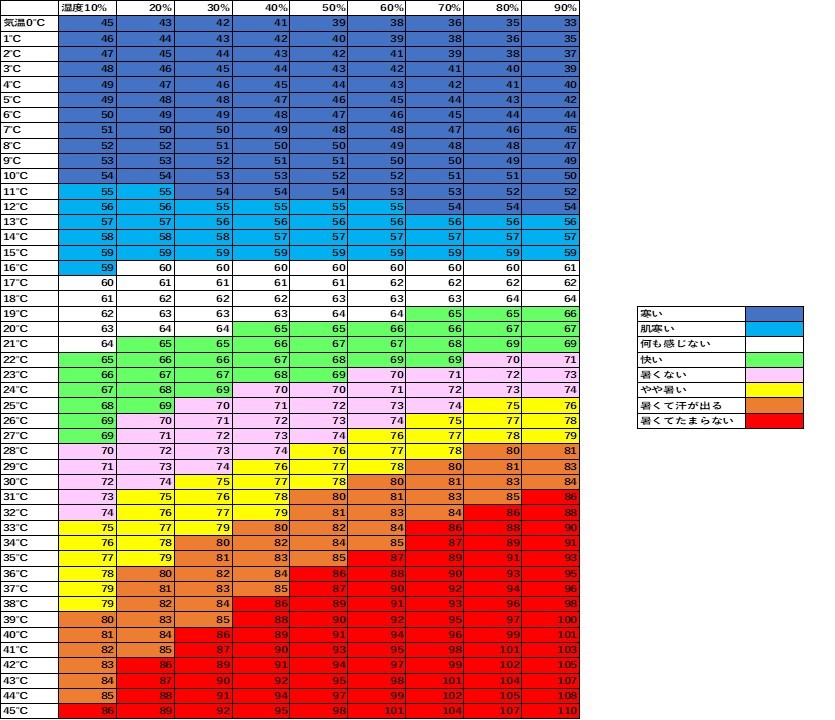06 快適な風速とは? -What is comfortable wind speed?-

English is written after Japanese.#English
今回は少し専門的なお話です。人間はどのくらいの風速を快適と感じるのでしょうか?
暑い日には風が欲しいと思う一方で、冷房などで常に風が当たるのもあまり心地よいものでもありません。風速の目安や理屈が分かれば、窓開けの仕方や、サーキュレーターや冷房のより良い方法が分かります。
快適風速の1つの目安として、気温28度の時には風速0.9~1.3m/sと言われています。暑さを和らげるための風速なので、外気温によって変わります。
この風速は、温度差換気(外部風なしで自然換気可能な方法)では実現不可能のため、外部の風や扇風機等の機械に頼る必要があります。ビューフォート風力階級表という目視で分かる風速の目安を示した指標によると、風速0.3~1.5m/sに当たり、煙がなびく、鱗の様なさざ波ができる程度の風速とあります。日常的な風景ですので、窓を開けることで、十分期待できる風速とも言えます。
ちなみに家庭用扇風機の風速は1~3m/s程度と言われていますから、数値上、弱・中くらいの風量で快適性が得られます。これは体感的に、納得できるのではないでしょうか。
一方で、不快感側の目安として、0.2m/s以上の風が室内で吹き続けると、人間は不快感を生じると言われています。これは主に空調の設計時に参照される目安ですが、日常生活でも参考になる数値です。言い換えると、既に快適な環境の室内において、風が吹き続けたら不快になるということです。
通常、既に快適な環境下(春秋等の中間期など)において、換気を行おうと思うことはあまりないと思われるので、この目安がネックになるのは、室内空調時と思われます。夏場には体感温度を下げるため、空調とサーキュレータの兼用が効率的ですが、風が当たり続けると不快感だけでなく、体の抵抗力が低下する等とも言われており、そのために風向は人の居ない方向に向けておくほうが良いでしょう。もちろん暑いから風に当たるというのはOKですが、就寝時などには気を付けておきたいポイントです。
因みに、2階建て住宅の1・2階の窓を全開にした温度差換気の場合、この風速を超えてくるので、常時開放の場合は開口面積を制限しておいた方が良いことが分かります。(どの程度がベストかは、前項05 換気量の目安と計画試案 -Ventilation volume guidelines and planning drafts-を参照ください。)つまり、温度差換気は前項の通り、目的のために希望する間だけ、希望する換気量を電気を使わずに実施できるという点では、とても優れた手法ですが、主に中間期の既に快適な環境下では、常時換気として利用しない方が良いとも言えます。
以下では、風速に関する基準や数値的な根拠を明示しておきます。
まずは、風速に関する法令・基準・推奨値などに関して、わかる範囲で列挙。
〈風速に関する基準・目安〉
①快適と感じる風速:気温34℃では、風速2m/s(※1)
②快適と感じる風速:気温30℃では、風速0.9~1.3m/s(※1)
③快適と感じる風速:気温28℃では、風速0.9~1.3m/s(※1)
④建築物における衛生的環境の確保に関する法律 (ビル管理法)で定めるユニット吹き出し口の風速:0.5m/s以下。(※日本人が不快と感じないために定められた基準値。1m程度離れた場所で0.25m/s以下になる様に定められたとも言われる。(根拠未確認))
⑤ASHRAE基準:0.35m/s以下(※アメリカ人が不快と感じないために定められた基準値)
⑥JIS基準(JIS E 6603:旅客車用空調基準):0.1~0.2m/s(ドラフトが起きない風速の目安)
上記の基準・目安の数値から鑑みると、夏場は体感温度を下げるために0.9~2m/s程度欲しいが、それ以外の時期には不快要素ともなるため不要となる、と考えられる。
〈温度差換気の場合の風速試算〉
室内外温度差を4℃程度と想定(実測例からの想定)すると、給排気窓の高低差Hと風速は以下の通り。(計算式省略。)
H=8m(3階建て相当)⇒ おおよそ0.6m/s以下。
H=4.5m(2階建て相当)⇒ おおよそ0.5m/s以下。
H=2.0m(平屋建て相当)⇒ おおよそ0.3m/s以下。
〈夏場の自然通風計画〉
一般住宅を想定した場合、残念ながら、この想定による温度差換気のみでは、夏場の望ましい風速は獲得できない。(※一応、H=4.5mの場合に、風速1m/sを超える温度差を探してみると、室内上部で30℃、給気口で18℃の時であったが、おおよそ現実的でない。)
そこでやはりエアコンの利用であるが、自然通風利用によりエアコンを付ける期間を最小化できないかを考えてみる。(個人差や熱中症のリスクもあるため、必要な際はエアコンはすぐ付けることをおすすめします。)不快指数表からみると夏場の東京の湿度約80%の場合、28℃程度で「暑くて汗が出る」範囲に入り、エアコンを付ける方が多いようである。

そこで外気温28℃、湿度80%(※3:8月、東京都)、風速0.6m/sの場合の体感温度は、25.8℃となる。上表では、「やや暑い」範囲であり、個人差もあるが、やはりエアコンスイッチに手が伸びてしまいそうでさる。
〈まとめと課題〉
・夏場に体感温度を下げるための風速は、0.9~2.0m/s程度。
・年中を通して不快とならない風速は、0.2m/s程度以下。
・「温度差換気」の考え方を利用する場合は、それのみで快適な通風を得ることは難しいが、大きな換気量は確保できるという点を考慮する。
・熱環境改善のためであれば、湿度や建物からの輻射、室内上下温度差など通風以外の要素の影響も大きい。
※1)野中俊宏 他著(2021)図解風の力で住まいを快適にする仕組み (株)エクスナレッジ
※2)体感温度計算サイト:https://keisan.casio.jp/exec/system/1257417058
※3)気象庁サイト:https://www.data.jma.go.jp/obd/stats/etrn/view/monthly_s3.php?prec_no=44&block_no=47662&year=&month=&day=&view=a7
What is comfortable wind speed?
This issue is a little technical. What wind speed do humans find comfortable?
We want a breeze on hot days, but on the other hand, a constant breeze from air-conditioning is also not very pleasant. If you know the guideline and theory of wind speed, you will know how to open windows and how to use a circulator or air-conditioning better.
One guide to comfortable wind speed is said to be 0.9-1.3 m/s at a temperature of 28°C. This wind speed is designed to relieve the heat, so it depends on the outside temperature.
This wind speed is not feasible with temperature differential ventilation (a method of natural ventilation without external wind), so you need to rely on external wind or a machine such as a fan. According to the Beaufort Wind Force Classification Table, an index of wind speeds of 0.3-1.5 m/s, the speed are smoke flutters and scale-like ripples are formed. Since this is an everyday scene, it can be said that this is the wind speed that can be fully expected by opening a window.
Incidentally, the wind speed of a household fan is said to be around 1-3 m/s, so numerically, comfort can be achieved at low and medium wind speeds. This may be satisfactory from our daily experience point of view.
On the other hand, as a guide to the discomfort side, it is said that humans experience discomfort when winds of 0.2 m/s or higher continue to blow indoors. This is a guide mainly referred to when designing air conditioning systems, but it is also a value that can be used as a reference in everyday life. In other words, if the wind keeps blowing indoors in an already comfortable environment, it will cause discomfort.
Normally, it is unlikely that you would want to ventilate in an already comfortable environment (e.g. in the middle of the year, e.g. spring and autumn), so this guide is likely to become critical point when air-conditioning the room. In summer, it is efficient to use both air conditioning and a circulator in order to lower the temperature, but it is said that continuous exposure to wind not only causes discomfort but also lowers the body’s resistance, etc. For this reason, it is better to direct the wind in the direction where no one is around. Of course, it is OK to get a breeze because it is hot, but it is important to take care when sleeping, for example.
In the case of temperature differential ventilation in a two-storey house with the windows on the first and second floors fully open, the wind speed will exceed this, so it is clear that it is better to limit the opening area if it is open all the time. (To find out how much is best, see the previous section 05 Ventilation volume guidelines and planning drafts -Ventilation volume guidelines and planning drafts-). In other words, as mentioned in the previous section, thermal differential ventilation is a very good method in that it can be implemented without electricity for the desired ventilation volume for the desired duration for the desired purpose, but it should not be used as constant ventilation, mainly in an already comfortable environment in the intermediate period.
In the following, the standards and numerical basis for wind speeds should be clearly stated.
First, a list of laws, standards and recommended values regarding wind speed, as far as they are known.
Standards and guidelines concerning wind speed
(1) Comfortable wind speed: 2 m/s at an air temperature of 34°C. (*1)
(2) Comfortable wind speed: 0.9 – 1.3 m/s at an air temperature of 30°C. (*1)
(3) Wind speed perceived as comfortable: At an air temperature of 28°C, wind speed 0.9-1.3 m/s (*1)
(4) Air velocity at unit vents as specified in the Law Concerning the Maintenance of a Hygienic Environment in Buildings (Building Management Law): 0.5 m/s or less. (*Standard value set to ensure that Japanese people do not feel uncomfortable, said to have been set to be 0.25 m/s or less at a distance of about 1 m. (Basis unconfirmed)). (Basis unconfirmed).
(5) ASHRAE standard: 0.35 m/s or less (*Standard value set to ensure that Americans do not feel uncomfortable).
(6) JIS standard (JIS E 6603: Air conditioning standard for passenger cars): 0.1~0.2 m/s (standard for air speed at which drafts do not occur).
In view of the values of the above standards and guidelines, it is considered that, in summer, a wind speed of 0.9 to 2 m/s is required to reduce the temperature of the body, but is unnecessary at other times of the year, as it can be an uncomfortable factor.
Trial calculation of air speed in the case of temperature difference ventilation
Assuming an indoor-outdoor temperature difference of approximately 4°C (based on actual measurements), the height difference H between the supply and exhaust windows and the wind speed are as follows. (Formulae omitted.) H = 8 m (3-storey building)
H = 8 m (equivalent to a 3-storey building) ⇒ approx. 0.6 m/s or less.
H = 4.5 m (equivalent to 2 storeys) ⇒ Approx. 0.5 m/s or less.
H = 2.0 m (equivalent to one-storey building) => approx. 0.3 m/s or less.
Natural ventilation planning in summer
Unfortunately, assuming an ordinary house, the desired air speed in summer cannot be obtained only by temperature difference ventilation based on this assumption. (*In case of H=4.5m, the temperature difference exceeding 1m/s was found to be 30°C at the top of the room and 18°C at the air intake, which is approximately unrealistic).
Therefore, air conditioning is still used, but we will consider whether it is possible to minimise the period during which air conditioning is turned on by using natural ventilation. (Due to individual differences and the risk of heat stroke, it is recommended that air conditioning is turned on immediately when necessary.) According to the discomfort index table, in Tokyo in summer, when the humidity is approximately 80%, the temperature falls into the ‘hot and sweaty’ range at around 28°C and many people turn on the air-conditioner.
So, if the outside temperature is 28°C, the humidity is 80% (*3: August, Tokyo) and the wind speed is 0.6 m/s, the temperature felt is 25.8°C. The above table shows that the temperature is in the “slightly hot” range, and although there are individual differences, it is likely that people will still reach for the air-conditioner switch.
Summary and issues
The air speed to lower the temperature in summer is around 0.9 to 2.0 m/s.
The wind speed that does not cause discomfort throughout the year is 0.2 m/s or less.
When using the concept of ‘temperature differential ventilation’, consider that it is difficult to achieve comfortable ventilation by this alone, but a large ventilation volume can be secured.
If the aim is to improve the thermal environment, factors other than ventilation, such as humidity, radiation from the building and the difference in indoor and outdoor temperatures, also have a significant impact.
(*1) Toshihiro Nonaka et al. (2021) Illustration: How the power of wind makes your home comfortable.
(*2) Website for calculating the temperature of the body: https://keisan.casio.jp/exec/system/1257417058
(*3) Japan Meteorological Agency website: https://www.data.jma.go.jp/obd/stats/etrn/view/monthly_s3.php?prec_no=44&block_no=47662&year=&month=&day=&view=a7
